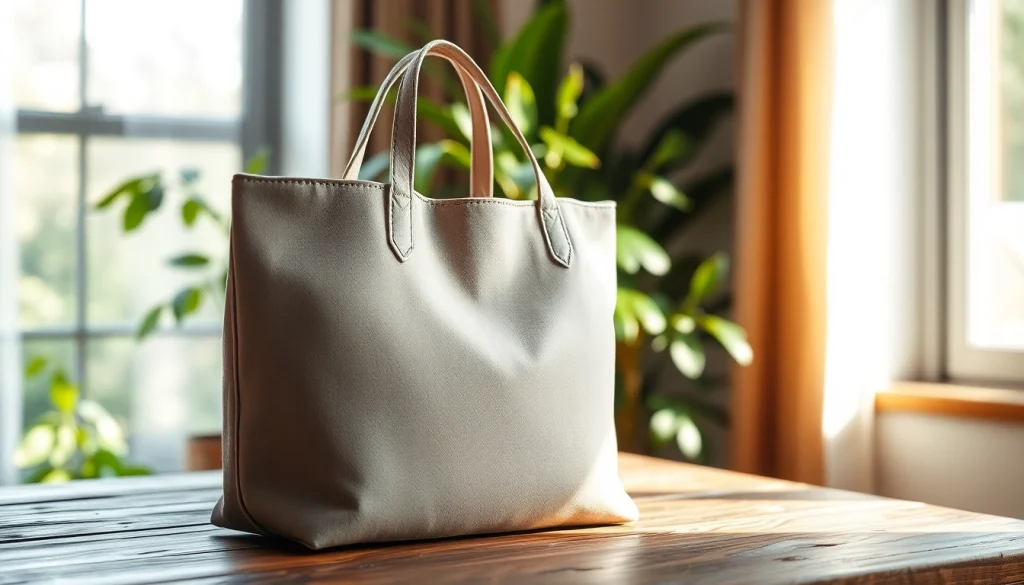
Understanding the Tote Bag
What is a Tote Bag?
A tote bag is a versatile and spacious type of bag characterized by its open top and two sturdy handles. Designed for practicality, these bags are often made from durable materials such as canvas, cotton, or synthetic fibers, making them suitable for a variety of uses. The unstructured shape allows for easy packing and unpacking, providing ample space for everyday essentials. This functionality has led to the Tote bag becoming a staple in many households and a popular accessory in contemporary fashion.
Historical Overview of Tote Bags
The evolution of the tote bag is an interesting narrative that reflects changing social norms and consumer needs. Originally, the term “tote” comes from the verb “to tote,” which means to carry. The earliest versions of tote bags were seen in the early 20th century, primarily used by farmers and laborers for carrying tools, produce, or personal items. These bags were made from heavy-duty materials, emphasizing functionality over style.
By the 1960s and 70s, tote bags began to gain popularity in more urban settings, thanks to their practicality for shopping and casual outings. Artists and designers started to reimagine this utilitarian item, leading to an explosion of creative designs, fabrics, and colors. Today, the tote bag stands as an iconic accessory and serves multiple purposes, from shopping to beach outings, and even as a fashion statement.
Common Uses of Tote Bags
Tote bags are incredibly versatile, making them suitable for numerous uses:
- Shopping: Many people opt for tote bags as a sustainable and stylish alternative to plastic bags when grocery shopping.
- Beach Bag: The spaciousness of a tote makes it ideal for packing swimwear, towels, sunscreen, and other beach essentials.
- Work/Office: A tote can also function as a professional bag, allowing individuals to carry laptops, documents, and personal items.
- Travel: When traveling, tote bags can serve as perfect carry-on luggage, providing easy access to travel essentials.
- Casual Outings: Whether for a picnic or a day out in the city, a tote bag is a convenient choice to hold personal belongings.
Choosing the Right Tote Bag
Considerations for Size and Capacity
Choosing the right size of tote bag is crucial to ensure it meets your needs. Consider your typical load; do you need it to carry a laptop or simply a few groceries? Tote bags come in various sizes, from small ones perfect for books to large, roomy styles ideal for overnight getaways. A bag with a capacity of 15-20 liters is typically suitable for daily activities, while larger bags (over 30 liters) can comfortably accommodate travel necessities.
Material Choices for Durability
The materials used in a tote bag significantly influence its durability and functionality. Here are some popular choices:
- Canvas: Known for its strength and durability, canvas tote bags can withstand heavy items and are often washable.
- Cotton: Lightweight and breathable, cotton is an excellent choice for casual use and can often be produced sustainably.
- Polyester: This synthetic fiber is water-resistant and easy to clean, making it suitable for outdoor use.
- Eco-Friendly Materials: Recycled materials and organic fibers appeal to environmentally conscious consumers.
Trendy Designs and Customization Options
In today’s market, tote bags are not just functional; they are also fashion statements. Trends include:
- Bold Prints: Eye-catching graphics and vibrant colors can make a tote bag stand out.
- Minimalistic Designs: Simple and chic designs with neutral tones appeal to a broad audience.
- Customizations: Many brands offer the option to personalize tote bags, whether through monograms, custom colors, or unique patterns.
Your choice of design can reflect personal style and make the tote bag a true extension of your identity.
Care and Maintenance of a Tote Bag
Cleaning Tips for Different Materials
Proper care of your tote bag can extend its lifespan significantly. Here are some material-specific cleaning tips:
- Canvas: Spot clean with a damp cloth and mild detergent. For deeper cleaning, machine wash on a gentle cycle.
- Cotton: Cotton bags can generally be washed in the washing machine. Check care tags for specific instructions.
- Polyester: Wipe down with a wet cloth and soap or machine wash if heavily soiled.
Storing Your Tote Bag Properly
When not in use, storing your tote bag properly can prevent damage and maintain its shape. Avoid folding it tightly; instead, store it upright in a cool, dry place. If it has been used frequently, consider stuffing it lightly with tissue paper to help maintain its shape.
Repairing Wear and Tear
Over time, wear and tear can occur, especially on heavily used bags. Address minor damages promptly by sewing up small tears or replacing worn-out handles. Many tailor shops offer repair services for damaged tote bags, extending their life even further. Additionally, using fabric glue can be effective for reattaching loose parts.
Environmental Impact of Tote Bags
Benefits of Using Eco-Friendly Tote Bags
Environmentally conscious consumers are increasingly favoring eco-friendly tote bags due to their low environmental impact compared to single-use plastic bags. Eco-friendly tote bags are often made from sustainable materials, helping reduce resource consumption and pollution. Their reusability also significantly lessens plastic waste, providing a better alternative for the environment.
Reducing Plastic Waste with Tote Bags
The use of tote bags can be instrumental in combating plastic pollution. According to studies, a single reusable tote bag can replace hundreds of plastic bags over its lifespan. By integrating totes into daily shopping habits, individuals can contribute to reducing the demand for single-use plastic, significantly benefiting local ecosystems.
Popular Sustainable Brands
There is a growing number of brands committed to producing sustainable tote bags, offering a variety of eco-friendly options. These brands focus on sustainable materials, ethical manufacturing practices, and responsible distribution. Supporting such brands not only promotes environmental responsibility but also helps foster a market for sustainable goods.
Maximizing Functionality with Your Tote Bag
Organizing Your Tote Bag for Easy Access
To maximize the functionality of your tote bag, organization is key. Consider the following tips:
- Use Pouches: Keep smaller items in separate pouches to prevent them from getting lost at the bottom of your tote.
- Designate Areas: Reserve specific sections of the tote for different items, such as a compartment for electronics and another for snacks.
- Color Code: Using color-coded pouches can simplify locating items and enhance your packing system.
Utilizing for Travel and Errands
Tote bags make excellent companions for both travel and running errands. When traveling, fill your tote with essentials like a travel pillow, a book, snacks, and important documents, keeping everything at arm’s reach while in transit. For errands, a sturdy tote can hold groceries, gym clothes, or office supplies, ensuring ease of carrying and efficiency.
Combining Style with Functionality
Today’s tote bags are designed with both style and functionality in mind. Look for totes that feature chic designs without sacrificing practicality—perhaps a tote with interior pockets, zip closures, or padded straps for comfort. This combination not only enhances the bag’s usability but also ensures that you can make a confident fashion statement no matter where you go.





